This Braided Einkorn Olive Oil Loaf, baked in a loaf pan instead of freeform, is enriched with eggs and olive oil and includes just a hit of sweetener. It’s a good loaf for toasting and spreading with jam or cheese.
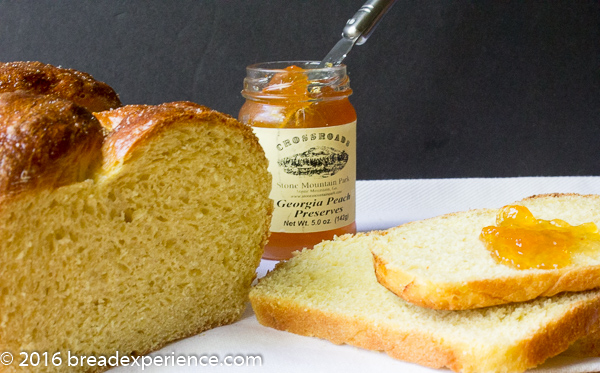
I was inspired to try this bread several weeks ago when a visitor asked if I had any recipes for Einkorn bread which included eggs. I was going to experiment with a regular sandwich-type loaf, but then I remembered how much I enjoyed this Italian Challah made with olive oil.
When I made the original version of this bread several years ago, most of the challah I had been making up to that point was made with eggs and butter as the enriching agents so it was a nice change to try it with olive oil. The olive oil gives it a slightly different texture and makes a healthier loaf.
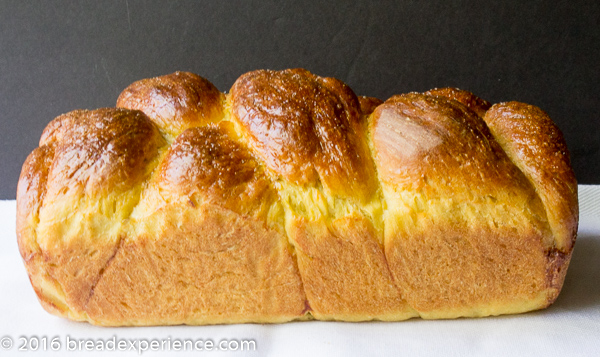
Braided Einkorn Olive Oil Loaf
Makes:
One Large Loaf
Ingredients:
- 500 grams all-purpose Einkorn flour
- 210-240 grams water
- 1 large egg
- 1 large egg yolk*
- 15 grams organic sugar
- 30 grams extra virgin olive oil
- 8 grams instant yeast
- 10 grams kosher salt
- 1 large egg (for egg wash) (*I used the leftover egg white for this part)
Equipment Needed:
- 9″x5″ bread pan
- Digital scale
- Extra oil for greasing
- Plastic wrap
Directions:
Whisk the dry ingredients together in a large mixing bowl. Mix in the wet ingredients adding in the water gradually. Mix thoroughly using a Danish dough whisk or wooden spoon until the dough comes together.
Cover with plastic wrap or a kitchen towel and let it rest for 20 – 30 minutes.
Fold and turn the dough a few times, then shape into a ball and recover.
Let the dough bulk ferment until doubled; 45 minutes to an hour.
Form into a Braided loaf
Remove the dough to a lightly floured work surface. Divide the dough into 3 balls about 280 grams each. Cover and let them rest on the counter for 20 minutes.
Roll each ball into a long rope. Then braid a 3-strand braid. Place the braid in a 9×5-inch greased parchment-lined loaf pan tucking the ends under if necessary.
For detailed instructions, including a photo tutorial, on braiding breads, refer Making Braided Bread: Challah.
Or shape into a regular pan loaf
Alternately, shape the loaf as a regular pan loaf by rolling it out (whether with a rolling pin or just by hand) to about 1/2 inch in thickness. The width should be no wider than the bread pan you intend to use. Then, roll up the dough tightly and make sure it seals well at the end.
Cover the braid with plastic wrap and allow it to double in size (should crest nicely above the rim of the pan). This will take 45 minutes to an hour. If you decided to make a free-form braid, just cover it with plastic wrap and allow it to double on the sheet pan.
Bake the loaf
Preheat your oven to 375 degrees F and place an empty steam pan on the bottom rack.
Whisk the extra egg (or egg white) and add a couple of teaspoons of water to make an egg wash.
Once the loaf is doubled, and just before placing in the oven, brush on the egg wash.
Transfer the loaf to the oven. Immediately add 1 cup of ice cubes to the steam pan and close the door.
Bake the loaf, turning the pan part way through baking, until the crust is a rich golden brown, about 20 minutes.
At the end of 20 minutes, remove the loaf from the pan and check if the lower crust is browned enough. If it is not sufficiently browned, place the loaf on a sheet pan or baking sheet, and put it back in the oven for another 5 minutes.
Allow to cool completely on a rack before slicing.
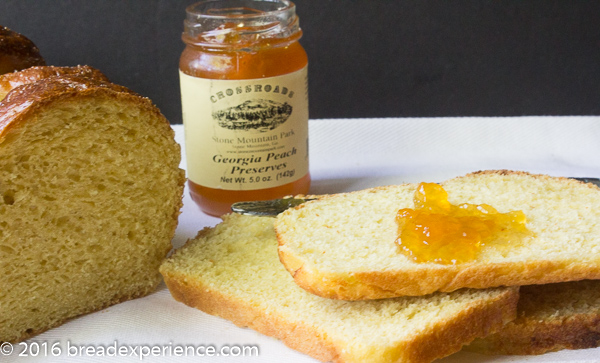
Enjoy with your favorite jam or cheese. It tasted really good with Georgia Peach Preserves, but it tasted equally good as the canvas for a grilled cheese sandwich.
Happy Baking!
Cathy
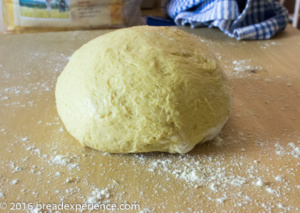
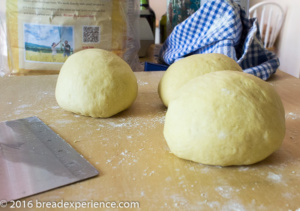
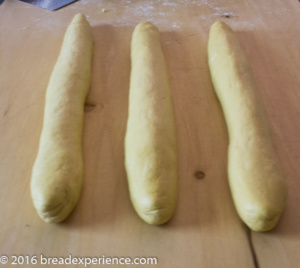
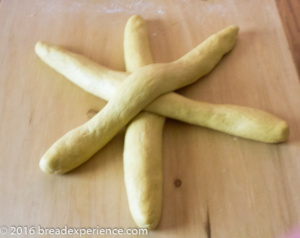
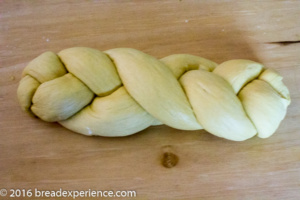
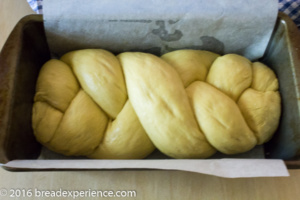
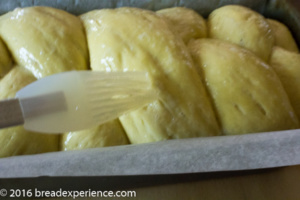
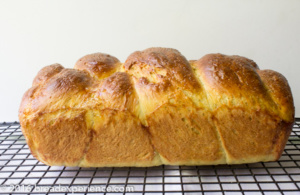
Jane T. says
The braided Einkorn olive oil loaf looks delicious. What brand and type of Einkorn flour do you recommend?
Cathy says
Hi Jane, this particular bread was made with all-purpose Einkorn. I get all-purpose Einkorn flour from Jovial Foods. For whole grain Einkorn, I usually buy the grains and then mill the flour myself. I’ve tried grains from several different companies. I like Jovial Foods but I have also bought from Einkorn.com.
harry aden says
hi
in this recipe you say let the dough double in size.
isn’t einkorn only meant to rise to 50%-75%?
i have a rugelach recipe that says proof for 1.5 hrs – shouldn’t i reduce by half?
if i have 2 1/4 dry yeast for a regular wholemeal recipe -how much should i reduce for einkorn?
i would also love to make this with wholemeal einkorn.
usually wholemeal is weighed at 96 grams a cup but here its 500grams i don’t know how many cups this is?
you also write in one of your blogs that when substituting einkorn for regular flour the liquid should be reduced by 15%-20%. i find that when i modify a regular white flour recipe to einkorn i first change that recipe to a regular wholemeal ie adjust liquid and oil and then decrease liquid from that amount like you said AND i decrease the oil (jovial advised as its to nutritious to absorb so much fat)
Einkorn may be substituted cup for cup with regular whole wheat flour in some muffin, pancake, cakes, and cookie recipes. However, sometimes the amount of liquid in the recipe needs to be reduced by roughly 15-20%.
just wondering how this works by you
thanks alot
Cathy says
Hi Harry,
I didn’t have a problem with letting the einkorn dough double in size for this loaf, but you can certainly let it rise 50-75% and then perform the test by pressing it lightly with your finger. If it’s proofed sufficiently, you’re good to go. If not, you can let it proof a little longer.
Rugelach sounds delish. I’ll have to try making it sometime.
I haven’t tried this particular loaf using whole grain einkorn, but because of the enrichments, it should be fine.
I recommend using 500 grams by weight rather than volume (cups) because measuring cups can vary. I have 4 different sets of measuring cups and the weights are different for each one. For basic flours (whole wheat, all-purpose, rye, bread flour) you can use an online calculator to convert from grams to cups, but I haven’t found any that show einkorn flour as an option.
If I was making this loaf with whole meal einkorn, I would use the same amount of flour (500 grams). However, depending on the type and coarseness of the flour, I would add more (or less) hydration. I did a test (on another blog post) with different brands of whole grain einkorn that I milled myself and the absorption rate was different between all of them.
I didn’t reduce the oil in this recipe, but you certainly can if you find that more to your liking. You can start with the lower amount and add more if needed.
Recently, I’ve been reducing the amount of dried yeast used for most recipes, not just einkorn. If a recipe calls for a packet of yeast or 2 1/4 tsp, I will go with 1 1/2 or 1 3/4. If I’m giving the dough an extended rise (like overnight in the refrigerator), I’ll use even less yeast. You may just have to experiment to find what works in your particular recipe.
If you do try this loaf with whole meal einkorn, do let me know how it goes.
Happy Baking!
Cathy
Rita says
Why are we to put an “empty steam pan” in the bottom of the oven? Are we not to put hot or cold water in the pan?
Cathy says
The instructions should say to add 1 cup of ices cubes to the steam pan immediately after placing the loaf in the oven. I just edited it. Thanks!